
Needle and Suture Pages: 1 2 3 4 5 Next>>
Needles and Suturing in the Golden Age of Piracy, Page 3
Adhesive Sutures
There were two alternatives to through-skin sutures which are discussed by golden age of piracy surgeons - gluing wounds and dry suturing. The first involves applying glue directly to small wounds to close them, similar to what is done today with tissue adhesives. The second uses adhesives to glue strips of material to the skin which are then sewn shut with suture. Let's look at each of them in more detail.
Adhesive Suturing: Gluing Wounds
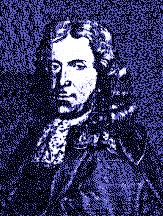
Matthias Gottfried Purmann
One of the period authors - German military surgeon Matthias Gottfried Purmann - discovered that glues could be used to close wounds. (He actually rediscovered this, as we shall see.) Purmann mentions two types of glue for this purpose in his book - joiner's glue and a plant-based glue.
Joiner glue was used to join wood to create finished woodwork in construction. Dionis explains that the use of "the Glut Fabril. or Glue that the Joyners use, is an excellent thing in the Cure of Wounds; which the Joyners know very well, and therefore when they chance to cut themselves, instead of a Plaister, they apply a Segmentum or Shaving spread with Glue; Tye it on, and let it lie till it has healed the Wound, and then it will drop off of it self."1
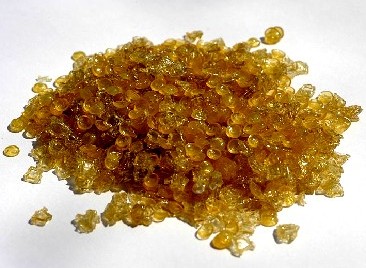
Photo: Simon Eugster - Animal Glue in Its Raw State
Joiner's glue was not purchased, but was most often made by the joiners themselves around the golden age of the pirates. Some glue manufacturing facilities do begin to appear in England around 1700,2 so it may have been possible to purchase it. The glues most likely used by joiners were animal based products.3 They are created by the extensive boiling of animal connective tissue found in skin, bones, tendons and other animal tissues.4 Evaporation concentrates the tissue, producing a jelly upon cooling which is dried to create the glue.5 Purmann must have found joiner's glue useful because he also suggests using it to seal bleeding vessels during amputation.6
He discusses another type of wound glue he saw used by a quack at Glogan (near Belgrade). The man "cut thirteen Wounds in the upper part of his left Arm, and after the Blood was wiped off, he apply’d to the Wounds only fine double Linen Rags moistned in a warm Mixture or Liniment, and then rolled up the Arm very Tight with a broad Roller."7 The next day, Purmann found the wounds "as good as healed, without any Inflammation or Swelling, and as neatly joined together as one would wish; insomuch, that they appeared quite whole"8

Photo: Andrew Massyn- The Salterra Sarcocolla Plant
A young surgeon living with Purmann purchased the recipe which Purmann gives in his book. It appears to have been a vegetable-based glue based on the sarcocolla plant. The name sarcocolla is literally a combination of the Greek words for 'flesh' and 'glue' and is mentioned as a wound healing substance by ancient surgeon and physician Galen in the 2nd century9. Purmann appeared to think quite highly of the recipe, explaining, "This Method may be truly call’d Glewing Wound together; which whoseoever practices, will find such Benefit by it, that he will never change it for the Ancient Greasy tedious Applications."10
While this is an interesting method, Purmann is the only period surgeon under study to discuss it, which suggests that it may have had limited use during this time. This seems unfortunate, given that it would have been such a quick and easy way for sea surgeons to treat wounds. However, it should be noted that a big problem with gluing wounds is that they must be fully cleaned before being shut or the risk of infection is high.11 Given the environment and the lack of understanding of germs, it may actually be better for ship's surgeons not to glue wounds.
1 Matthias Gottfried Purmann, Churgia Curiosa, p. 111; 2 R.D. Adams, Adhesive Bonding: Science, Technology and Applications, p. 10; 3 W. Patrick Edwards, "Why Not Period Glue?", Journal of the Society of American Period Furniture Makers, November 2001, gathered from the internet 2/16/15; 4 "Animal glue", wikipedia.org, gathered 2/16/15; 5 Edwards, p. 11; 6 Purmann, p. 211; 7 Purmann, p. 181-2; 8 Purmann, p. 182; 9 "Sarcocolla", wikipeida.org, gathered 2/16/15; 10 Purmann, p. 182; 11 D. Brady Pregerson, "Suturing and Wound Closure, Part 2", consultant360.com, posted 4/27/11, gathered 2/17/15
Adhesive Suturing: Dry Stitching
Dry suturing is another wound closing technique that made use of adhesives to close wounds, one which enjoyed much wider popularity during this time period. It is actually an ancient practice. The Edwin Smith papyrus, which dates to 1500-1600 BC explains that once a wound is stitched with normal sutures, "'[i]f thou findest that wound open and its stitching loose thou shouldst draw together for him the gash with two strips of linen.' From other references it is learned that the linen strips were coated with an adhesive mixture of honey and flour thereby creating the original skin closure strips."1
Dry suturing is mentioned by period surgeons in two situations: as a method for closing wounds of the face and as a way to secure normal stitches that the surgeon believes might loosen without added support.
Ambroise Paré advises that when "a wound of the cheek seems to require a suture, it must
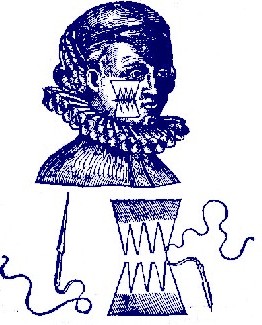
Cheek Suture and Tools, From The Workes of that
Famous
Chirurgion Ambrose
Pare,
p. 256 (1649)
have a dry suture (as they term it) lest that the scar should become deformed. For that deformity is very grievous to many, as to women, who are highly pleased with their beauties."2 French surgical instructor Pierre Dionis likewise explains that dry sutures are "extraordinary effectual in Wounds of the Face, by reason that avoiding the deforming marks occasion’d by the Points of the Needle, the remains of them are very little seen after their Cure."3 Surgeon Richard Wiseman employed a dry suture in a wound of a woman's forehead.4 Of course, ship's surgeons did not usually have to dress wounds on women.
The other use of a dry stitch is the same as that mentioned in the Edwin Smith papyrus at the beginning of this section: as a sort of backup to traditional through-skin suturing. Richard Wiseman suggests the surgeon use dry stitching "for the strengthening of Bandages, or for the preserving of the [through-skin] Stitches"5. He also suggests their use upon finding a wound is not fully healed after the through-skin sutures are removed.6 However, he is the only period surgeon under study to advise the use of this technique.
The tools required for dry suturing are completely different than those for regular stitching. As Dionis explains it does not "want either Needle, Thread
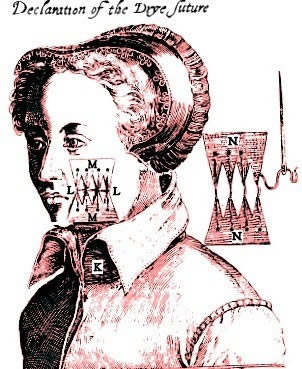
Guillemeau's Dry Suture Diagram, From
Jacques
Guillemeau's The French
Chirurgerie (1597)
or Pipe [cannula]."7 French surgeon Jacques Guillemeau describes the tools used for this operation in some detail with a well-executed diagram.
Declaratio[n] of the Characters, which are contaynede in the drye Suture, or stitchinges.
K, the portraychure one the which the drye suture is applyede.
L, L, the longitude of the wound which is in the cheeke.
M, M, Two Linnen cloutes [pieces of cloth], which are gluede on the face.
*,*,*,* The thredes which passe through the Linnen cloutes, therebye to be drawne, joynede, and knittede together.[Note - the various *s are seen inside of the the jagged pieces of cloth, although they look a bit like dots.]
N, N, Bothe the peeces of Linne[n] clothe which are separatede the one from the other.
*,*,*,* The thredes which are passed through both the endes.8
Richard Wiseman provides some further insight into the make-up of dry suturing tools required for dry sutures. He explains that the material was "made with little bits of strong linen Cloath, triangular and quadrangular, or of such a figure as may serve your purpose."9 Dionis recommended using leather instead of linen as we shall see shortly.
Wiseman also provides a prescription for the glue spread on the pieces of material to be attached. It is a vegetable-based glue, containing "a Mixture of sang. dracon.
Photo: Carsten Niehaus - Astragalus Tragacantha Plant
[Sanguis Draconis - Dragon’s Blood, a red vegetable gum], thuris [frankincense], aloes, farin tritic. [farina tritici - wheat flour] gum tragacanth. [gum from the dried sap of Middle Eastern legumes of genus Astragalus] an. [mixed with] part. aequal cum albumin ovi [equal parts of egg white]"10.
Ambroise Paré gives a recipe for another adhesive, albeit one containing several of the same ingredients: "Rx. pulveris mastichini [powdered mastic tree resin], sanguinis Draconis [Dragon’s Blood], thuris [frankincense], farinæ volatilis [finely ground wheat flour], tranagaganthæ contusæ [bruised gum from the dried sap of astragalus plants], gypsi [gypsum - Plaster of Paris], picis [pitch], sarcocollæ an. {of each, 2 drams} picis nigræ [black pitch] {one and one half dram} albumina ovorum quæ sufficient [mix with a sufficient amount of egg white], fiat medicamentum [to make the medicine]."11
It is notable that Paré's recipe contains sarcocolla, the substance which was recommended by Matthias Gottfried Purmann for gluing wounds together in the previous section.
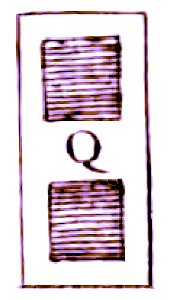
Dry Suture Single, From Pierre
Dionis' Cours d'Operations,
Fig VII, "Les Sutures", p.50 (1708)
For the procedure itself, we turn to meticulous French surgical instructor Pierre Dionis. He discusses two different methods of dry suturing, "because sometimes [it is] perform’d with a single piece of Stuff, and at others with two."12
When dry suturing with only one piece, the surgeon
takes a small bit of Cloth or Leather, shap’d like those mark’d Q, which he covers with strong Glue, or some viscous Ingredient which sticks it fast to the Skin, as Meal [corn] intermix’d with the White of an Egg; he applies one moiety [less than half a portion] of it on one side of the Wound, and when fix’d on the Skin, he draws the Cloth by its remaining part, in order to apply it on the other side, where sticking it very fast [the adhesive is shown in the diagram as the dark areas with vertical lines], by that means closes the two Lips of the Wound: This Suture is very easily performed, but is solely proper to be apply’d to superficial Wounds.13
This essentially creates what we think of today as a Band-aid®. It could be a useful method for strengthening existing sutures in the manner Richard Wiseman described, although it would prevent the surgeon from easily examining the sutures beneath the strip of material.
Dionis' second method is similar to that described by Paré and Guillemeau in their diagrams, although Dionis uses small pieces of leather in his diagram rather than one long strip of linen as Paré and Guillemeau show. He explains that this
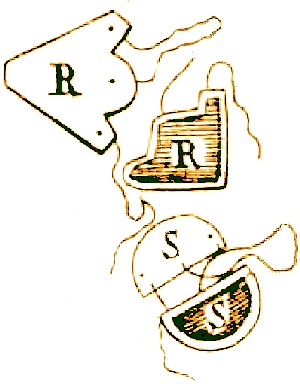
Dry Suture Matching Leather Pieces, From Pierre Dionis'
Cours d'Operations, Fig VII, "Les Sutures", p.50 (1708)
kind of dry Suture is not so lightly performed; the Chiurgeon takes two small bits of Leather, R, R, cut in a triangular Form, on one side of which are three Indentures, to each of which if fastn’d a small Thread; these Leathers are spread with some [adhesive] Ingredient which sticks them fast to the Skin, and the Chirurgeon lays one of them on one of the Lips of the Wound, and other on the other, taking care that the two Places on which they are laid be about a Finger’s breadth distant from the extremities of the Edges of the Wound, as is expressed by R; after which, by drawing the ends of the Thread, he causes the Lips of the Wound to close, and tying the Thread together by a double Knot keeps them join’d so that the Re-union may easily be accomplish’d.
Some sew the Indentures to one another, or fix buckles on them in order to pass through a small String; and others only make use of two small bits of Leather mark’d S S, spread over with the same Remedy [adhesive], and provided with the same threads, Tapes, or Ribbons; but this does not alter the Species, and serves only to the same end.14
Ambroise Paré's instruction are similar to Dionis, although there is an point of interest in his description. After the adhesive-coated material is applied, he orders the reader to "let it alone till it be hard dryed to the skin."15 (Obvious, but it is curious that the usually precise Dionis didn't point that out.)
1 David Mackenzie, "The History of Sutures", Medical History, April 1973, p. 159; 2 Ambroise Paré,The Workes of that Famous Chirurgion Ambrose Parey, p.293;3 Pierre Dionis, A course of chirurgical operations: demonstrated in the royal garden at Paris. 2nd ed., p. 44; 4 Richard Wiseman, Of Wounds, Severall Chirurgicall Treatises, p. 362; 5 Wiseman, p. 349-50; 6 Wiseman, p. 345; 7 Dionis, p. 43; 8 Jacques Guillemeau, The French Chirurgerie, (13th unnumbered page in the beginning); 9,10 Wiseman, p. 345; 11 Paré, p. 293; 12 Dionis, p. 43; 13 Dionis, p. 43-4; 14 Dionis, p. 44; 15 Ambroise Paré, p. 293
Adhesive Suturing: Dry Stitching - Post-Operation
Once a wound without through-skin suturing was dry sutured, it had to be kept as still as possible in order for the lips of the wound to reunite. Ambroise Paré advises this will heal "together with the use of fit medicines, pledgets [pieces of folded, absorbant lint], ligatures [ribbons, threads or similar things]. But all the ligatures and stayes [possibly splints made with pieces of wood or bone1 designed to keep the patient from moving the area of the wound] which shall be used for this purpose must be fastend to the patients night-lap [an 'overnight hood' worn on the head2]."3
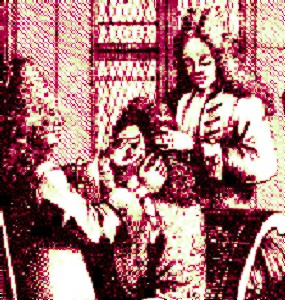
From A General System of Surgery,
by
Lorenz
Heister,
Plate 17 (18th c.)
Unfortunately, Paré doesn't detail the medicines to be applied to the wound. Richard Wiseman suggests the use of agglutinates such as were used on material at the first dressing and then switches during the second dressing to "sarcotick Powders [medicines to encourage the growth of flesh], which supplied the place of Epuloticks [preparations which promotes wound healing]"4.
Dry sutured wounds would be finished with a dressing after the medicines were applied. Such dressings would be designed to keep the wound as immobile as possible to allow for healing. In a wound of the forehead, Wiseman used a roller bandage which he started "behind [the head of the patient], bringing both the heads of the Rowler forward, passing one another, to press the Lips of the Wound in the Forehead close together."5 He redressed the wound after two days.
For dry suture removal, Pierre Dionis explained that "nothing is requisite but Water to moisten the bits of Linen or Leather stuck to the Skin, which being wetted easily come off.”6
Modern author and former British Royal Navy surgeon John Kirkup provides some interesting insights into the use of dry sutures during this era from a modern perspective.
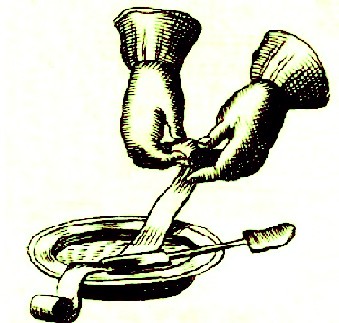
Preparing A Strip,From L'Arcenal de Chirurgerie by
Johannes Scultetus, p 105 (1653)
Apart from being pain-free in application, an adhesive plaster worked at least as well for small wounds as did needle-inserted suture material, for both were liable to cause local inflammation, infection, and delayed healing. However, complications were more profound and more persistent with [through skin] sutures, for each added two skin perforations to the wound with resultant greater morbidity....
However, plaster strips also had their problems, for adhesive power varied from one product to another and also depended on the availability of plant gums, myrrh, mastic, and balsam, as well as animal glues, pastes, honey, and other sticky products. Even if the adhesive was sterile, the fabric or cloth used was not, and wounds might gape as adhesion failed or infection took hold.7
The use of dry sutures may not have been widely employed at sea. While discussing wounds of the face, sea surgeon John Woodall says, "I will not stand to teach the drie stitch here, for it is not proper at sea, it fits the land better."8 He instead advises his charges to use "articiall and convenient binding the lippes of the wound together [using bandages], with also a sure naturall balme [a medicine to promote wound healing]"9. Note that while he dismisses dry sutures, Woodall still avoids through-skin suturing on the face to prevent disfiguring scars.
1 Thanks to Jeff Gedney for suggesting this idea in a discussion on the Authentic Pirate Living History Group Facebook page; 2 John Callaway, A Vocabulary, with Useful Phrases and Familiar Dialogues, in the English, Portuguese and Cingalese Languages, 1818, p. 21 - Thanks to Lee Morrisroe for finding this resource and interpreting its meaning; 3 Ambroise Paré,The Workes of that Famous Chirurgion Ambrose Parey, p.293; 4,5 Richard Wiseman, Of Wounds, Severall Chirurgicall Treatises, p. 362; 6 Pierre Dionis, A course of chirurgical operations: demonstrated in the royal garden at Paris. 2nd ed., p. 44; 7 John Kirkup, The Evolution of Surgical Instruments; An Illustrated History from Ancient Time to the Twentieth Century, p. 335; 8,9 John Woodall, the surgions mate, p. 137

